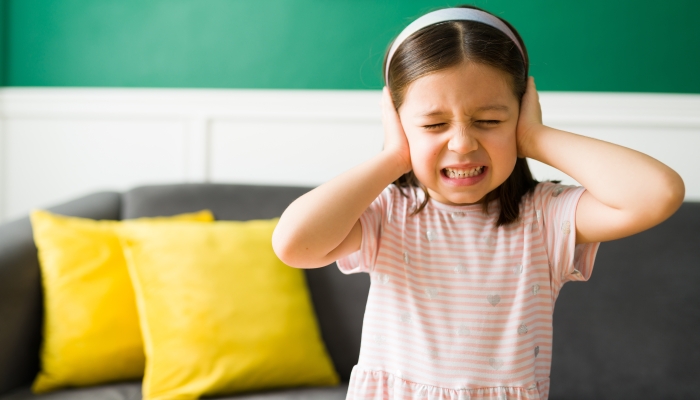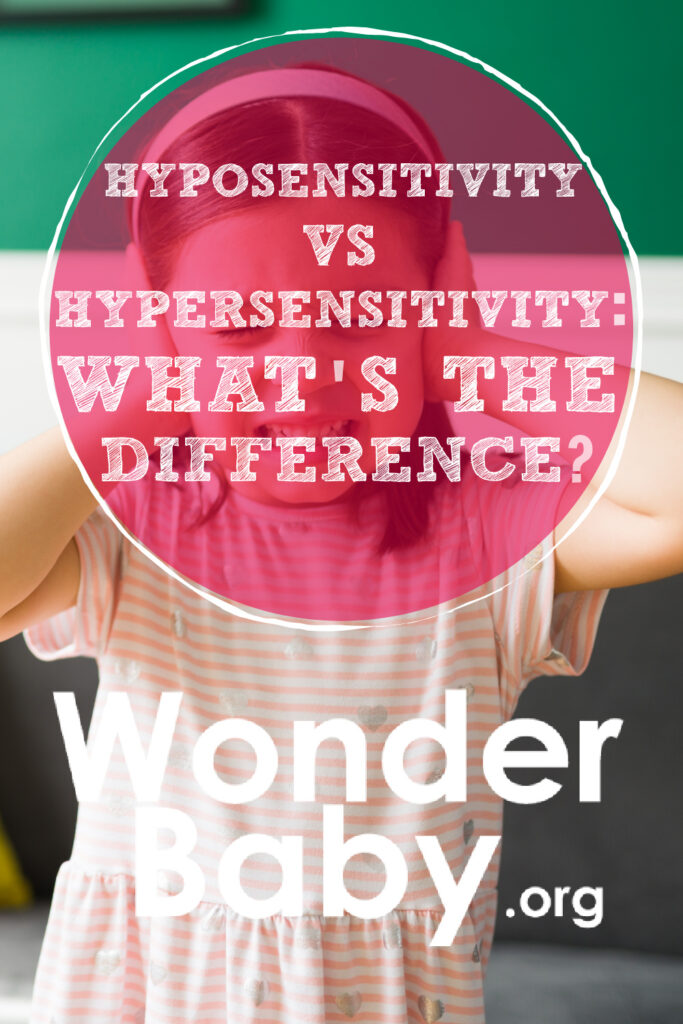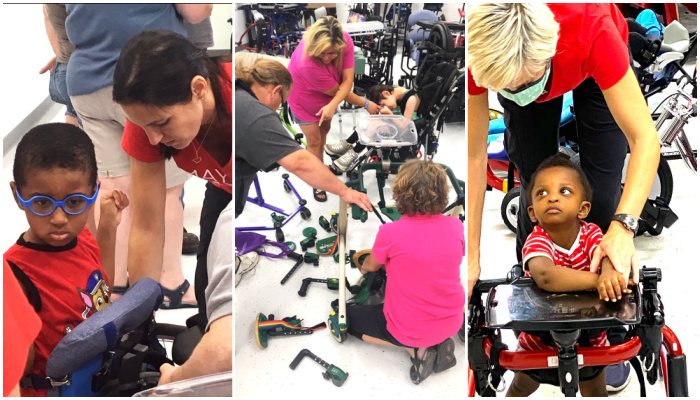Hyposensitivity vs Hypersensitivity: What’s the Difference?

This post may contain affiliate links; please see our terms of use for details.
- Hyposensitivity is a decreased responsiveness to incoming sensory information.
- Hypersensitivity is an increased responsiveness to incoming sensory information.
- Children with hyposensitivity may seek additional sensory information, while children with hypersensitivity may avoid stimulating experiences.
- Hyposensitivity and hypersensitivity may look different for each sense (vision, touch, smell, taste, and hearing).
- Sensory processing difficulties are common with autism diagnoses but may also be present in neurotypical children.
My daughter loves to crash into objects, flip, roll, and spin around the house. She likes strong flavors, bright lights, and lots of hugs and squeezes. I, on the other hand, avoid loud noises and crowds at all costs, hate spicy food, and would be 100% okay if I never spun in another circle.
We can look a bit like hyposensitivity versus hypersensitivity—my daughter, the sensory seeker, may be a little hyposensitive to sensory stimuli, while I, the sensory avoider, may be a little hypersensitive. And, whew, does it lead to some difficult evenings when she wants to crawl all over me and I want to be left alone!
Learning to cope with her need for lots of sensory input versus my need for quiet time without distractions has been difficult. However, there are strategies that may help manage sensory sensitivities.
Does your child seem to react in an unusual manner to sensory input? Do they crave tons of input or have meltdowns if there is too much going on? Your child may be exhibiting signs of hyposensitivity or hypersensitivity.
What Is Hyposensitivity?
Hyposensitivity is a decreased response to sensations. A child who is hyposensitive may fail to notice certain temperatures, sounds, or where their body is in space. Their nervous system does not respond appropriately to sensory input and requires more stimuli to interpret the world around them.
Because children with hyposensitivity are not as aware of sensory input, they typically seek out even more input so their brain can successfully perceive their environment.
Sensory seekers may get themselves into trouble since they may not be aware of danger. They often throw themselves into situations with extreme force, which may lead to accidents and injury. Children who seek out more sensory input may also be loud and messy when they play.
Children with hyposensitive sensory systems may have vestibular hyposensitivity (decreased responsiveness to head movement), and decreased reactions to smells, sounds, tastes, and touch. A hyposensitive child may even feel pain less than most children.
Though children with hyposensitivity tend to enjoy novel experiences and exploration, they may still experience developmental delays. Since they are not as aware of body sensations as other children, they can have clumsiness or coordination problems that lead to difficulty with fine or gross motor skills. This is due to decreased reaction to proprioceptive input, or information about where their body is in space.

How to Tell if a Child Has Sensory Hyposensitivity
Your child may show some or all of these signs of hyposensitivity, though this is not an exhaustive list:
- Likes strong flavors like spicy, bitter, or sour.
- May not notice hot or cold foods, objects, or weather.
- Seeks proprioceptive input by crashing into objects, spinning, or rolling. Also enjoys fast movement.
- May fall or stumble frequently and show other signs of clumsiness. May seek railings, the wall, or other objects for stability while walking.
- Enjoys messy play.
- Frequently talks, sings, or makes noises to themselves. May make repetitive noises to stimulate their auditory system.
- Bangs on musical instruments or other surfaces to make loud noises.
- Wants to touch everything when entering a new space and has difficulty controlling impulse to touch objects.
- Likes to smell or taste new objects and does not mind strong odors.
- Enjoys firm hugs, squeezes, and weighted vests or blankets.
- Chews or tries to eat inedible objects.
- Likes bright colors and flashing lights.
If these behaviors interfere with everyday life, talk to your child’s pediatrician about your concerns. They may refer them to an occupational or physical therapist to address a sensory processing disorder or developmental delays.
Strategies to Manage Hyposensitivity
Having a child who constantly seeks sensory experiences can be exhausting! However, sensory seeking children also create a lot of fun, new experiences. If you’re feeling overwhelmed, try some of the following strategies to manage your child’s hyposensitivity:
- When your child is upset, provide firm hugs and deep pressure around their torso. A weighted blanket may also soothe your child.
- Make time during the day to allow them to engage in loud, busy play. Give that time a special name like “loud time” so your child knows when it is time for their busy play to stop and start.
- Set up a sensory swing, particularly one that will also spin in circles, to give your child vestibular input throughout the day.
- Control your child’s environment. If there are objects that are breakable, dangerous, or very messy, keep them out of your child’s reach or locked up so they do not pick these objects up or try to eat them.
- Have your child wear a weighted vest during play or walks if they are very clumsy, uncoordinated, or fall frequently.
- Add extra spices or herbs to your child’s food and introduce new foods and combinations.
- Anticipate your child’s needs if they don’t notice hot and cold. They may still need a jacket even if they don’t complain of the cold. Keep hot food and pans out of reach!
- [A RELAXING SPACE FOR KIDS ] Aokitec sensory kids swing help your children relax and get their bearings in. The cocoon swing provides a hug-like effect for little ones. The wonderful experience and sensory input will let your kids spend hours in.
- [SOFT SILKY NYLON] This therapy swing is made of high quality material–soft & silk nylon. It measures 110″L x 62W”. Kids can sit and cocoon comfortably in the hammock with a sense of calmness. Our updated hammock can block out unwanted sensory stimulation.
- [FOR SPECIAL NEEDS] Ideal of this cuddle swing is designed for kids and teens who have sensory Processing Disorder,or those on the autism spectrum. The kids swing helps child learn body awareness, balance, motor planning, and spatial skills. It also provides sensory pressure all over and creates a fun space to bounce, swing, spin, or lie down enjoying the movement of the swing.
- [ALL HARDWARE INCLUDED &EASY USE] This indoor sensory swing comes with extra accessories, including daisy chain, O-sling, carabiner, U-hook , expansion screws x4 and self-tapping screws x4. And you can refer to the installation video or the instruction which is attached with the product, so that the installation will be very easy.
What Is Hypersensitivity?
Hypersensitivity is an increased reaction to sensory input. These children have sensory systems that are always on high alert. Sensory stimuli that do not bother most children may cause the hypersensitive child to feel pain because sensations are so strong.
Children with hypersensitivity may have a fight or flight reaction to loud noises, strong flavors, and flashing lights. This can result in meltdowns, hitting, running away, or refusal to participate in certain activities, particularly in children who are younger and have not learned self-regulation.
Children learn by exploring their environment and social interactions. Hypersensitivity may contribute to developmental delays if your child frequently avoids new experiences and interactions with others. Slowly introduce your child to situations they find triggering. If a child is pushed into uncomfortable situations, this may strengthen their resistance.
A goal for the hypersensitive child is to fully participate in daily activities and to be comfortable exploring familiar environments and practicing new skills. It’s important as a parent to provide a safe space for your child to do so.

How to Tell if a Child Has Sensory Hypersensitivity
When sensory hypersensitivity disrupts your child’s ability to function in their normal environments (home, school, play spaces), you should call your pediatrician and discuss referral to an occupational therapist who can work on sensory integration therapy with your child.
Your child may exhibit some, or all, of the following behaviors, though any of these behaviors on their own do not necessarily indicate a problem:
- Puts hands over ears when there are loud sounds (e.g., fireworks, vacuum, hand dryers, toilet flushing).
- Increased anxiety when in crowded or busy areas.
- Prefers bland foods and may refuse to eat, or spit out, certain foods with strong or unusual flavors. May also gag or throw up when tasting certain textures.
- May avoid hugs and kisses, even with adults they’re very comfortable around.
- Dislikes certain clothing textures and may complain about fabrics and tags.
- Avoids messy play and unusual textures like scratchy, squishy, or wet objects.
- Prefers calm, controlled, and predictable environments.
- Becomes upset during hygiene activities like baths, teeth or hair brushing, and clipping nails.
- Likes muted colors and light and may cover eyes around bright or fluorescent lights.
Strategies to Manage Hypersensitivity
- Buy clothes in preferred fabrics and colors. Remove tags or other irritating accessories.
- Slowly introduce new foods and textures. Allow your child to explore the food and don’t force them to finish it. Each food may need to be introduced several times.
- Encourage your child to participate in hygiene activities.
- Provide noise-canceling headphones or earplugs when very loud noises can’t be avoided.
- Respect your child’s bodily autonomy and do not force hugs or kisses.
- Have a plan when going to very stimulating environments. If your child becomes upset, find a quiet place to let them calm down.
- Slowly introduce messy play and teach your child to clean their play space to decrease anxiety associated with messes.
- 【Extremely Comfortable to Wear】: Wrap your child’s ears in cloud-like softness! Dr.meter noise cancelling headphone is made of premium memory foam cores with PU leather padding, creating a breathable seal that stays cozy during monster jams, fireworks, concerts, or even long-term sports events. Designed for providing comfortable wearing—no itching or pressure marks!
- 【SNR 27.4dB Noise Reduction】: This kids earmuff is cutting-edge acoustic engineering meets mom-approved protection; ABS shells+ triple-layer sound-dampening foam block harmful decibels at monster truck rallies while keeping voices clear for “Mommy, look!” moments. It reduces noise (by 27.4 dB SNR/20dB NRR) but does not completely block sound, suitable for noise sensitive kids, child concentration aid, and autism sensory.
- 【Adjustable Headband to Fit All】: The headband of the noise cancelling headphone for kids can smoothly adjust to fit different head sizes, from toddlers and children to teenagers and even adults. Tips: If you feel the earmuff is too tight when you use it for the first time, you can put it on the package box (or size 3 soccer ball) for 4 hours to loosen it.
- 【Double-Certified Safety】: Breathe easy with ANSI S3.19-1974 & CE EN 352-1 certified hearing armor. Our noise-canceling earmuffs are meticulously designed to provide optimal safety. With an impressive SNR of 27.4 dB, they excel at reducing noise and protecting your kids’ ears as well as your own hearing.
Hyposensitivity vs Hypersensitivity: In Comparison
While hyposensitivity is decreased responsiveness to sensory input, hypersensitivity is increased responsiveness to sensory input. Children with hyposensitivity engage in sensory seeking and children with hypersensitivity engage in sensory avoiding. Both forms of sensory sensitivity indicate that the brain is not processing sensory information appropriately.
It’s possible that some children will present with hypersensitivity for certain senses and hyposensitivity with others, but in general, children will be either overly sensitive or under sensitive to sensory stimulation across multiple body systems.
For both the hypersensitive and hyposensitive child, a safe space should be created to maximize development through play. The hypersensitive child will prefer a controlled environment with minimal distractions. The hyposensitive child will require a space free from dangerous objects that allows them to play rough and messy.
FAQs
Can a child have sensory issues without autism?
Yes! While it is common for children with autism spectrum disorder (ASD) to also process sensory information differently, that does not mean that only children diagnosed with autism can have trouble integrating sensory input.
Children with no other diagnoses may have sensory processing disorder. Sensory abnormalities may also be present after premature birth or along with a diagnosis of ADHD, genetic conditions, or brain injuries.
Can sensory issues be outgrown?
Typically, sensory issues continue into adulthood. However, children can learn to regulate their response to sensory information and improve their awareness with the help of an occupational therapist.
Autistic children are likely to benefit from ongoing occupational therapy throughout their childhood since sensory sensitivity tend to affect participation in everyday activities.

The information WonderBaby provides is not intended to be, and does not constitute, medical or other health advice or diagnosis and should not be used as such. Always consult with a qualified medical professional about your specific circumstances.
Related Posts

Special Needs
5 Spring Cleaning Tips for Families of Children with Disabilities
Spring cleaning is an opportunity to create a more accessible, organized, and supportive space for your child with disabilities. Declutter, deep clean, and refresh!

Visual Impairment
The Gift of Understanding: How a Young Child Helps His Blind Father Navigate Life
When a parent is blind, it’s natural for people to wonder how their sighted child will adapt. Will they struggle to understand their parent’s needs? Will they feel burdened by...

Assistive Technology, Support
May We Help: Engineering Independence for People with Disabilities
May We Help is dedicated to designing and building custom solutions that help individuals of all ages achieve mobility, access, and independence, all at no cost.

